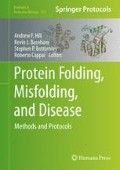Abstract
Transmission Electron Microscopy of negatively stained and cryo-prepared specimens allows amyloid fibrils to be visualised at high resolution in a dried or a hydrated state, and is an essential method for characterising the morphology of fibrils and pre-fibrillar species. We outline the key steps involved in the preparation and observation of samples using negative staining and cryo-electron preservation. We also discuss methods to measure fibril characteristics, such as fibril width, from electron micrographs.
Access this chapter
Tax calculation will be finalised at checkout
Purchases are for personal use only
References
Goldsbury, C., Goldie, K., Pellaud, J., Seelig, J., Frey J., Muller, S.A., Kistler, J., Cooper, G.J.S., Aebi, U. (2000) Amyloid Fibril Formation from Full-Length and Fragments of Amylin. Journal of Structural Biology. 130, 352–362.
Lashuel, H.A., Hartley, D.M., Petre, B.M., Wall, J.S., Simon, M.N., Walz, T., Lansbury Jr, P.T. (2003) Mixtures of Wild-type and a Pathogenic (E22G) Form of Aβ40 In Vitro Accumulate Protofibrils, Including Amyloid Pores. Biochemistry. 332, 795–808.
Nieva, J., Shafton, A., Altobell III, L.J., Tripuraneni, S., Rogel, J.K., Wentworth, A.D., Lerner, R.A., Wentworth Jr., P.W. (2008) Lipid-derived aldehydes accelerate light chain amyloid and amorphous aggregation. Biochemistry. 47, 7695–7705.
Sorci, M., Grassucci, R.A., Hahn, I., Frank, J., Belfort, G. (2009) Time-dependent insulin oligomer reaction pathway prior to fibril formation: Cooling and seeding. Proteins. 77, 62–73.
Krysmann, M.J., Castelletto, V., Kelarakis, A., Hamley, I.W., Hule, R.A., Pochan, D.J. (2008) Self-Assembly and Hydrogelation of an Amyloid Peptide Fragment. Biochemistry. 47, 4597–4605.
Engel, M.F.M., Khemte’mourian, L., Kleijer, C.C., Meeldijk, H.D., Jacobs, J., Verkleij, A.J., de Kruiff, B., Killan, J.A., Hoppener J.W.H. (2008) Membrane damage by human islet amyloid polypeptide through fibril growth at the membrane. PNAS. 105, 6033–6038.
Thorn, D.C., Ecroyd, H., Sunde, M., Poon, S., Carver, J.A. (2008) Amyloid Fibril Formation by Bovine Milk αS2-Casein Occurs under Physiological Conditions Yet Is Prevented by It’s Natural Counterpart, αS1-Casein. Biochemistry. 47, 3926–3936.
Nilsson, M.R. (2004) Techniques to study amyloid fibril formation in vitro. Methods. 34, 151–160.
Serpell, L.C., Sunde, M., Fraser, P.E., Luther, P.K., Morris, E.P., Sangren, O., Lundgren, E., Blake, C.C.F. (1995) Examination of the Structure of the Transthyretin Amyloid Fibril by Image Reconstruction from Electron Micrographs. Journal of Molecular Biology. 254, 113–118.
Inoue, S., Kuroiwa, M., Saraiva, M.J., Guimaraes, A., Kisilevsky R. (1998) Ultrastructure of Familial Amyloid Polyneuropathy Amyloid Fibrils: Examination with High-Resolution Electron Microscopy. Journal of Structural Biology. 124, 1–12.
Jimenez, J.L., Nettleton, E.J., Bouchard, M., Robinson, C.V., Dobson, C.M., Saibil, H.R. (2002) The protofilament structure of insulin amyloid fibrils. Proceedings of the National Academy of Sciences. 99, 9196–9201.
Binger, K.J., Pham, C.L.L., Wilson, L.M., Bailey, M.F., Lawrence, L.J., Schuck P., Howlett, G.J. (2008) Apolipoprotein C-II Amyloid Fibrils Assemble via a Reversible Pathway that Includes Fibril Breaking and Rejoining. Journal of Molecular Biology. 376, 1116–1129.
Gras, S.L., Tickler, A.K., Squires A.M., Devlin, G.L., Horton, M.A., Dobson, C.M., MacPhee, C.E. (2008) Functionalised amyloid fibrils for roles in cell adhesion. Biomaterials. 29, 1553–62.
Goldsbury, C. Kistler, J., Aebi, U., Arvinte, T., Cooper, G.J.S. (1999) Watching Amyloid Fibrils Grow by Time Lapse Atomic Force Microscopy. Journal of Molecular Biology. 285, 33–39.
Hayat, M.A. (ed) (2000) Principles and Techniques of Electron Microscopy (4th Ed) Cambridge University Press, Cambridge, UK.
Cohen-Krausz, S., Saibil, H.R. (2006) Three-dimensional Structural Analysis of Amyloid Fibrils by Electron Microscopy in Protein Reviews (Uversky, V.N., Fink A.L., ed.) Springer, USA, pp. 303–313.
Bremer, A., Henn, C., Engel, A., Baumeister, W., and Aebi, U., Has Negative Staining still a place in biomacromolecular electron microscopy? Ultramicroscopy 46, 85–111, 1992.
Taylor, K.A., Glaeser, R.M. (1974) Electron diffraction of frozen, hydrated protein crystals. Science. 186, 1036–7.
Dubochet, J., McDowall, A.W. (1981) Vitrification of pure water for electron microscopy. Journal of Microscopy. 124, RP3-RP4.
Adrian, M., Dubochet, J., Fuller, S.D., Harris, R.J. (1998) Cryo-negative staining. Micron. 29, 145–160.
De Carlo, S., El-Bez, C., Alavarez-Rua, C., Borge, J., Dubochet, J. (2002) Cryo-negative staining reduces electron-beam sensitivity of vitrified biological particles. Journal of Structural Biology. 138, 216–226.
Cavalier, A., Spehner, D., Humbel, B.M. (ed.) (2009) Handbook of Cryo-Preparation Methods for Electron Microscopy, CRC Press, Taylor and Francis Group, Boca Raton, FL, USA.
Author information
Authors and Affiliations
Corresponding author
Editor information
Editors and Affiliations
Rights and permissions
Copyright information
© 2011 Springer Science+Business Media, LLC
About this protocol
Cite this protocol
Gras, S.L., Waddington, L.J., Goldie, K.N. (2011). Transmission Electron Microscopy of Amyloid Fibrils. In: Hill, A., Barnham, K., Bottomley, S., Cappai, R. (eds) Protein Folding, Misfolding, and Disease. Methods in Molecular Biology, vol 752. Humana Press, Totowa, NJ. https://doi.org/10.1007/978-1-60327-223-0_13
Download citation
DOI: https://doi.org/10.1007/978-1-60327-223-0_13
Published:
Publisher Name: Humana Press, Totowa, NJ
Print ISBN: 978-1-60327-221-6
Online ISBN: 978-1-60327-223-0
eBook Packages: Springer Protocols

